![]() 1st Battalion 22nd Infantry
1st Battalion 22nd Infantry ![]()
John Dowdy
Commanding Officer 1st Battalion 22nd Infantry
"He was a fountain of strength at which all men might drink."
In the two hundred year history
of the 22nd Infantry John Dowdy was one of the most aggressive,
yet charismatic, Commanders
that 1st Battalion and the 22nd Infantry Regiment has ever seen.
He led his men always from the front, never expecting them
to do anything he was not prepared to do himself. He inspired
courage in his Battalion, motivating his Soldiers to continue
pressing on in the face of extreme hardships, regrouping them
after costly setbacks from the enemy, and instilling in them
the dedication to ultimate victory which was the essence of his
fighting spirit.
Thanks to the efforts of his cousin, Karen Scott, his story has come to light, to ensure that he will never be forgotten.
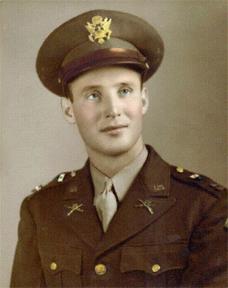
Lieutenant Colonel John Dowdy
1st Battalion Commander LTC John
Dowdy - 1944
John Dowdy served his entire military career with the 22nd
Infantry. Though details of that career are sketchy and
incomplete,
the following is an historical sketch of one of the most dynamic
leaders the Regiment has ever seen. In thirty-eight total days of
combat
John Dowdy received the Distinguished Service Cross, two Silver
Star Medals, two Purple Heart medals and the Combat Infantryman
Badge.
John Dowdy entered the US Army from the University of Georgia on
June 15, 1939 as a 2nd Lieutenant in the 22nd Infantry.
On February 25, 1941 he was promoted to 1st Lieutenant. On
February 1, 1942 he received a promotion to Captain, becoming,
at the age of 23, one of the youngest Captains and Company
Commanders in the Army at that time. On August 16, 1943
he was promoted to Major and served on the Regimental Staff of
the 22nd Infantry's Commander, Colonel Hervey Tribolet.
Sometime in late 1943, prior to the Regiment sailing overseas in
January of 1944, Dowdy was made Executive Officer of the 2nd
Battalion.
On D-Day June 6, 1944 he came ashore on Utah Beach with 2nd
Battalion in the second wave of the landings. On June 9, Dowdy
was sent to 1st Battalion to become its Executive Officer. On
June 12 he assumed command of 1st Battalion.
Dowdy took 1st Battalion inland from the beach area, as the 22nd
Infantry became the right flank of the 4th Division's point of
attack.
The Regiment's mission was to reduce the enemy strongpoints along
the beaches and destroy the heavily fortified batteries
several miles inland. Positioned on the high ground between
Dodainville and Azeville were two German battery forts, one at
Azeville
and the other at Crisbecq. Each fort consisted of four massive
concrete blockhouses containing the artillery batteries, the guns
at Crisbecq being 210mm long barreled monsters. The Crisbecq
battery was one of the most powerful coastal battery forts of
the entire German Atlantic Wall. Both forts were protected by
interconnected trenches, pillboxes, barbed wire and automatic
weapons.
For four days the Regiment
battled fierce German resistance in the attempt to take these
forts, while suffering heavy casualties
in the process. Azeville and Crisbecq were taken, as were Ste.
Marcouf and Ozeville. The last major strongpoint on the way
to Cherbourg was the heavily fortified high ground of the
Quineville ridge. On June 14 the 22nd Infantry and one Battalion
of the 39th Infantry attacked this high ground with tank support.
Dowdy took 1st Battalion, with its supporting tanks
of the 70th Tank Battalion, and captured the eastern part of the
ridge, and another hill to the east of that. For his actions that
day
he was awarded the Distinguished Service Cross. The citation for
that award read:
"For extraordinary heroism in action against
the enemy on June 15, 1944 (sic). Fierce artillery, machinegun,
mortar and small arms fire
inflicted heavy casualties upon Lt. Col. Dowdy's command as it
attacked high ground. One assault company, having lost all of its
officers
and most of its key non-commissioned officers, became completely
demoralized; withdrawal was imminent. Friendly tanks operating
in support of the attack began to retreat. Realizing that his
entire command was threatened with annihilation, Lt. Col. Dowdy,
disregarding completely his own safety, moved afoot through a
hail of fire and personally directed the fire of the tanks upon
the enemy.
Courageously he proceeded forward unfalteringly to the forward
elements of his command. While under fire, he organized them
for an attack. Lt. Col. Dowdy's exemplary actions spearheaded a
devastating assault, which resulted in the capture
of the strongly fortified position and more than 100
prisoners."
For the next several days the Regiment assembled and received
replacements, and on June 19 began the drive toward Cherbourg.
By June 22, 1st Battalion was holding high ground near
Gonneville, on the extreme right flank of a three Division
assault
upon the fortress city. For six days the Regiment held the flank
and prevented German forces from linking up with the city.
On the last day of continuous action, June 27, while leading his
Battalion, Dowdy suffered serious shrapnel wounds to his right
leg
from enemy artillery. Refusing to be evacuated, he remained in
command for 18 hours after being wounded, most likely until
the surrender of all German forces east of Cherbourg, at 1330
hours on June 28. For his actions that day John Dowdy
received the Silver Star and Purple Heart.
Dowdy spent the months of July and August in a hospital in
England recovering from his wounds, and was promoted to
Lieutenant Colonel on July 21, 1944. He rejoined the Regiment on
September 1, 1944. Colonel Charles "Buck" Lanham was
then
in command of the 22nd, and Dowdy became part of Lanham's staff.
During the three days of September 1-3, Dowdy became
Lanham's "right-hand-man". In those three days the
Regiment fought its way across more than 100 miles of France and
Belgium,
with Lanham and Dowdy directing its movements and operations. On
September 4 Dowdy resumed command of 1st Battalion.
Lanham wrote of Dowdy:
"When this fight was
over I gave John back his battalion (ed.,
1st Battalion) which had
suffered heavily in his absence.
Within twenty-four hours it was like a new outfit. John was
everywhere and his courage, his strength, his spirit, and his
personality
ran like flame through the command. I think he was the greatest
leader of men that I have ever seen, and I have spent a lifetime
in the Army.
And certainly no man has ever been more deeply loved by those he
led and by those who had the high privilege
of serving with him as fellow officers.
John was with us when we
broke the Siegfried line on 14th. The blow that he and his
battalion struck that day will never be forgotten
by our enemy. We ruptured the line on September 14th and on
September 15th we continued the attack to widen the breach
and to improve our positions. The fighting was bitter and the
enemy was fanatical. The troops that opposed us were largely SS
formations,
the elite of the German Army, with orders from Hitler in person
to fight to the death. And in large measure this is what they
did.
On September 16th John and his battalion again took their
objective—a critical hill in our zone. The enemy reaction
was violent.
He made repeated efforts to throw John from his hard-won
position, but these were beaten off. He then resorted to violent
artillery
and mortar fire— this was probably the heaviest series of
concentrations we have ever received. John ordered his battalion
to dig in
on the high ground for the night. He then began circulating among
his troops; adjusting their positions, correcting their
dispositions,
placing his weapons in the most advantageous locations, joking
with the men, reassuring them, seeing to their safety.
He walked through the storm of shellfire as if he were walking
down a street in his home town—calm, cool, completely
composed,
and without the slightest trace of hurry or excitement. He was a
fountain of strength at which all-men might drink.
He made two complete circuits of his position, and still not
satisfied that his men were adequately cared for, he began a
third trip.
He was perhaps halfway through when the fatal shell landed. He
was killed instantly, and though it might well have been
otherwise,
his body was not mutilated. Only a fragment of the shell did the
deadly work."
Charles B. MacDonald, in the book “The Siegfried Line
Campaign” described the above action thus: “The only bright development
on this part of the front came in the afternoon of 16 September
when the 1st Battalion pushed out of the Pruem State Forest
to seize a hill that commanded the Bleialf-Pruem highway a few
hundred yards west of the German-held village of Sellerich.
Even this achievement was marred by the loss from German shelling
of some thirty-five men wounded and eight killed,
including the battalion commander, Lt. Col. John Dowdy.” (p. 53)
For his leadership and bravery under fire, at the cost of his
life on that September day, John Dowdy was awarded his second
Silver Star
and second Purple Heart. He was 26 years old when he died.
Regimental Chaplain Bill Boice
wrote of Dowdy: "One
of the finest officers of the regiment, Lt. Colonel John Dowdy
had proved himself
an able officer in combat again and again. His personal care for
the troops under his command, his knowledge of military tactics,
had saved lives and boosted morale."
Perhaps the best tribute to John Dowdy was written by Colonel
“Buck” Lanham, in a personal letter to John's mother,
Eva, when he wrote:
"....I have seen many
officers and many men go down. Each one, no matter how humble,
has been a blow and a personal loss to me.
But I say truthfully that never has a death so stunned me as that
of John. And the Regiment shared that grief with me.
John was worshipped by his battalion; it was a form of hero
worship, and John was a hero and died a hero,
in the true sense of that much abused word."
LTC John Dowdy was buried in the US Military
Cemetery at Fosse, Belgium. For several years a Belgian family
adopted the grave
and kept it well looked after, making sure it always had fresh
flowers. On April 8, 1949 LTC Dowdy’s body was returned to
the US
and he now rests in the Dowdy plot in Tifton, Georgia.
**********************
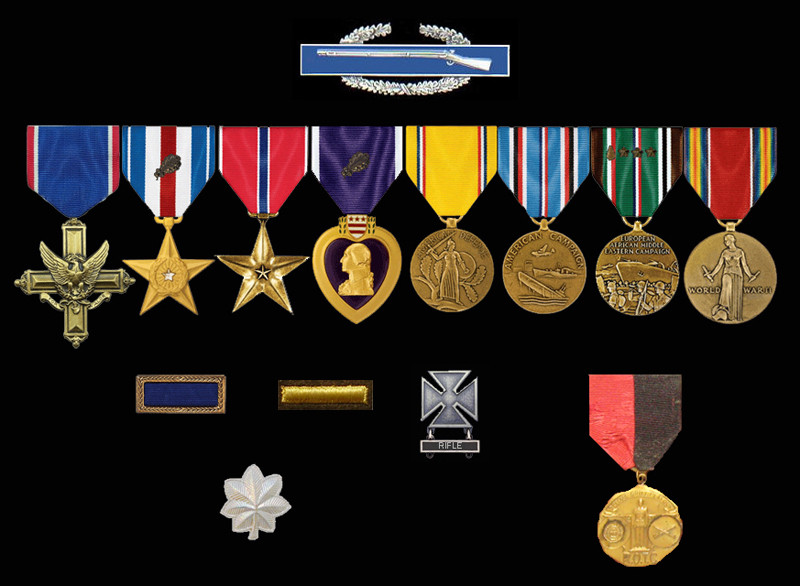
LTC John Dowdy's decorations which
could be verified by 1st Battalion website.
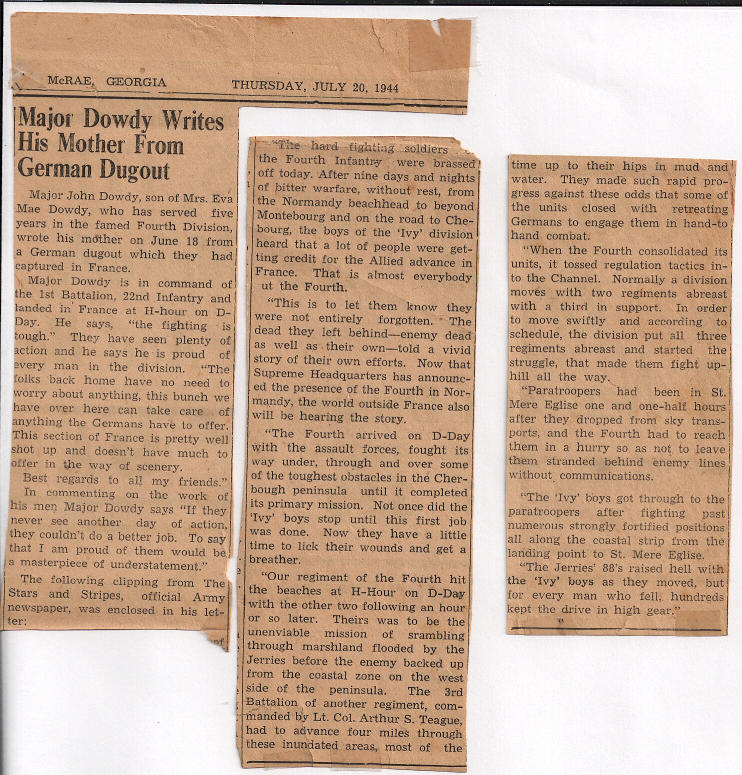
Newspaper clipping from the McRae
Enterprise about a letter John Dowdy wrote to his mother,
in June of 1944, when he was a Major commanding 1st Battalion.
Dowdy's feelings about the Soldiers he led are illustrated by his
statement above:
"To say that I am
proud of them would be a masterpiece of understatement."
An article concerning another letter John Dowdy wrote home during this time was published in:
The Daily Tifton Gazette 13 July 1944
"The McRae Enterprise
recently published a letter to Mayor John Stamps, of McRae,
written by Maj. John Dowdy
with ink captured from the Germans in France. He stated that his
outfit, an infantry unit, had been in the midst of things in
France,
and that the action gets pretty hot at times. He acknowledged
receiving a ballot and said there was no time for formality
when artillery shells and small arms bullets were falling near.
Major Dowdy is a brother of H P Dowdy of Tifton ______
son of Mrs Eva Mae Dowdy, former superintendent of the Hospital
here."
**********************
John Dowdy and the drive to Cherbourg
None of the Battalions of the
22nd Infantry reached their objectives on D-Day, June 6. On June
7 the attack
toward Cherbourg began in earnest, with the 22nd Infantry meeting
some of the most determined German resistance
faced by the 4th Infantry Division. On June 28, the German
garrison at Cherbourg formally surrendered,
marking the end of the first stage of the Normandy campaign. In
the twenty-two days it took to go from
the landing on Utah Beach, to the surrender of the city fortress
of Cherbourg, the 22nd Infantry Regiment
lost 23 officers and 373 enlisted men killed, and 104 officers
and 1560 enlisted men wounded.
That amounted to 2060 total casulaties, from a Regiment whose
normal strength was 3200 men.
The following excerpts were
taken from the 22nd Infantry Daily Action Journal, covering the
period
June 7-26, 1944. Only those passages which mention John Dowdy by
name are presented.
(In one instance his last name is misspelled as
"Doughty".) Regrettably, the action for which he was
awarded
the Distinguished Service Cross is not mentioned, nor is the
action for which he received his first Silver Star and Purple
Heart.
As a major on the staff of the
2nd Battalion, Dowdy was in a position to be sent all over the
battlefield,
to help in the coordination of movements of the various units.
From the excerpts it appears that Dowdy moved back and forth
between 1st and 2nd Battalions, until such time as he permanently
took command of 1st Battalion.
1st Battalion was led ashore on
D-Day, June 6, by its commander, LTC Sewell S. Brumby. On June 7,
during the initial attack
upon Crisbecq, the Battalion was met with fierce resistance by
the Germans, including artillery fire from the Azeville batteries
and counterattacks by German infantry. During this phase Brumby
was wounded in his foot severely enough
to have had to relinquish command of the Battalion to his
Executive Officer Major James E. Neal. The 22nd Infantry Daily
Journal
for June 7 states Major Neal was in "bad shape".
Captain Thomas C. Shields, Commanding Officer of Company A,
took temporary command of the Battalion and ordered a withdrawl,
as strong enemy ground forces were advancing upon his company.
Receiving grevious wounds, CPT Shields refused evacuation,
ordered his men to the rear, and called down artillery fire
upon his own position, giving the Battalion time to safely
withdraw from the battlefield. For his actions that day,
Thomas Shields was posthumously awarded the Distinguished Service
Cross and the Purple Heart.
That same day Major James E.
Neal resumed command of 1st Battalion. On June 8 Major Neal was
wounded in the ankle,
but was not hospitalized. Major John Dowdy was brought to 1st
Battalion to become its Executive Officer on June 9, 1944.
On June 12, Major Neal was seriously wounded and evacuated and
John Dowdy became Commander of 1st Battalion.
These excerpts do not provide
the entire record of the 22nd Infantry or the 1st Battalion in
the attack toward Cherbourg.
Since only passages which mention Dowdy are presented, they are
here to give a rough illustration
of the kinds of action and activities John Dowdy experienced
during this time.
June 7, 1944
From 1700 to 1730 hours, we have cut loose with naval fire for
1st Battalion. They are hurting. They have lost all machine guns
and mortars.
They have also lost a bunch of men and officers. They are pretty
disorganized. German 88-mm shells are raising hell in their
midst. Maj Kenan told Maj Dowdy,
at 2nd Battalion, that the Nazis are firing into the Regimental
CP now and then. He wants an observer at Company E. Dowdy
wants artillery fire and ammunition.
A Prisoner was brought to the CP and questioned. Call Major
Edwards, Commander of 2nd Battalion, to tell him that there is no
artillery fire now. Capt Russell,
Commanding Company G, was killed in action. Major Edwards says
it's rough down there. Artillery and Naval fire is falling on
enemy positions.
From 1800 to 1900 hours, the situation in the 2nd Battalion is
not too good, can't get artillery in there. Company G is moving
up. They want artillery
to lift their fire a little. Maj Dowdy needs
three 536 radios. The 1st Battalion has moved back 600 yards, and
the organization is good.
Company D has drifted back. Maj Neal is in command. The 2nd
Battalion is located southeast of Azeville. Their situation is
good. The left flank is wide open,
however. There is no contact with 12th Infantry on left. They are
trying to contact 1st Battalion on right. Col Ruggles arrived at
the CP to check on the situation
and to report on it later. Lt. Jackson takes command of Company
G.
From 1900 to 2000 hours, Capt Kemp, in 3rd Battalion, is asking
Maj Kenan what Col Teague's (3rd Battalion Commander) new job is.
Col Goforth is hoping that Teague can stay with his Battalion.
Everything is straight between them. From 1st Battalion, the
situation is shaping up for the better. 1st Battalion plans to
stay where they are for the night. Col Ruggles told Col Tribolet,
Regimental Commander,
that all units are stabilized and OK. Tribolet advised to be
prepared for a counterattack. Ruggles reported the situation; two
officers captured,
Company C captured about 100 prisoners. The 1st Battalion is down
to their last three 81 mm mortars and a couple of 30 mm machine
guns.
He asked what Col Tribolet wants to do about Col Teague and was
told to relieve him. Tanks were reportedly observed in front of
2nd Battalion area.
Maj. Edwards and Maj. Dowdy gave Maj. Kenan a
record of the day's events. The air bombardment for 2100 hours is
approved.
72 bombers will take part in the mission.
From 2000 to 2120 hours, Maj. Dowdy, in 2nd
Battalion, said German 88mm guns are giving them trouble.
Skirmishing has resumed.
Dowdy asked for bombardment of the 88mm gun
which is about 500 yards from them. Maj. Kenan will inquire if it
is possible. Maj Kenan called Dowdy back
to say that it is impossible to give an air bombardment tonight.
Plan for tomorrow morning instead. Wire communications are not
effective. Kenan suggested
putting in a switchboard. The 2nd Battalion reports to Maj Kenan
that there is a lot of snipers. They come in like Japs. We
cleaned out snipers in a house and,
half hour later, they got two more in same house. The bastards
come right on in. There was more talk about the bombardment.
Edwards thinks he will need it.
Edwards says the boys in 2nd Battalion learned a lot today.
June 8, 1944
From 1100 to 1200 hours, Col Ruggles advised Maj Dowdy
that 1st Battalion is in the 2nd Battalion's zone. Company E is
still having trouble.
Company G is coming in on Company E's left flank. Patrols were
organized under Capt Moon and Capt Warr to canvass the country
side to pick up civilians.
Col Ruggles advised 2nd Battalion that 42 men just left Regiment
for 2nd Battalion area. Naval gun fire was hitting one mile ahead
of 2nd Battalion.
Col Ruggles advised 1st Battalion that they were in the 2nd
Battalion area and to get back to their own area so that 2nd
Battalion could get some artillery fire
on German machine guns in Azeville.
From 1200 to 1300 hours, General Barton, 4th Division Commander,
leaves the CP and stopped to talk to some NCO's to say that the
Division was in good shape.
There was a long conversation between Col Ruggles, Maj Edwards in
2nd Battalion and Maj Dowdy about where to put
artillery fire.
Maj Edwards will call back as to exact spot he wants it. Maj
Dowdy wanted to put naval gunfire on Quineville but Col
Ruggles said not to because it was
out of his sector for the time being. Estimated Regimental losses
up to midnight last nightwere KIA 9, Captured 0, Missing 59 and
wounded 81.
A battalion of artillery is firing on a point given by Maj
Dowdy with the range and deflection correct. Maj
Dowdy and Col Teague are talking about moving
two companies of 3rd Battalion to the location of 2nd Battalion.
From 1630 to 1700 hours, the 2nd Battalion started to fall back
to last night's lines. Col Ruggles thinks the Germans have been
reinforced with a battalion
or reinforced regiment. Maj Dowdy told Col
Ruggles that he would keep naval fire coming in on them and for
Ruggles to keep the artillery fire coming.
Ruggles wanted to use smoke but the wind was blowing in the wrong
direction. Artillery requested the location of the German
battalions.
Col Ruggles gave Division the situation. He told them about the
prisoner who gave the information on the reinforced regiment to
our front.
Col Tribolet told Division about a prisoner who said a German
division (the 248th) is to our front and is planning to attack us
tonight.
The 4th Division told Col Tribolet that the Division is going to
attack between the 22nd Infantry and the 12th Infantry but could
not give the exact time
it was coming off. Division also requested us to warn troops not
to mistake our reinforcements as enemy troops. We will send our
the time of attack later.
From 1900 to 2100 hours, Regiment reported that to date,
approximately 300 Nazi prisoners have been evacuated from
Regimental enclosures.
Others were sent to the beach directly by the 3rd Battalion. The
2nd Battalion reported they were sending back two prisoners who
they thought would be willing to talk.
They also reported very little firing was going on at present.
Regiment informed 2nd Battalion to swing Company F back and along
fence line. Also informed them
about 1st Battalion's Maj Neal's injury. Maj Dowdy
will take command of 1st Battalion until Neal is able to get
around.
Maj Dowdy was told to make a reconnaissance
before dark. (Note: Neal's wound proved to be minor and he
continued in command
of 1st Battalion. Dowdy was sent to 1st
Battalion on June 9.)
June 9, 1944
From noon to 1300 hours, Maj Edwards with 2nd Battalion was asked
if they could spot the German 88 in Crisbecq and he could not.
Col Tribolet wants Maj Edwards to have his naval support officer
direct fire on Crisbecq plus some mortar fire. Seems that they
have the 3rd Battalion naval fire,
the 2nd Battalion naval fire, 20th Field Artillery fire, 44th
Field Artillery Fire, mortar fire and tanks firing into Crisbecq.
The Germans there are taking a severe beating.
The 1st and 2nd Battalions are holding their positions while the
3rd Battalion is moving in on their objective of Azeville. The
2nd Battalion reported seeing rockets
believed to be hitting in 3rd Battalion area. They were asked to
see if artillery got the azimuth for the firings. The 2nd
Battalion got a compass reading on the rocket gun
and sent it to artillery. They are now laying down a barrage. Maj
Dowdy in 1st Battalion is asking about the current
situation. Their artillery observer
is sending in a reading on rockets projectory as well.
June10, 1944
From 1300 to 1400 hours, Regiment asked 2nd Batalion where the
bombing was but nobody seemed to know. Col Ruggles at Regiment
asked Maj Dowdy
in 1st Battalion to move his unit up next to Teague's
3rd Battalion. He said the 1st Battalion would be on the right of
3rd Battalion. He also told him
to coordinate with Teague and not to rush into it. Blazzard, with
3rd Bn, asked Col Ruggles for protection on his flank. Ruggles
told him
that Maj Dowdy was going to move in there.
Blazzard said they could take Ozeville. An air bombardment was
definitely on Crisbecq at 1320 hours.
Another air bombardment is on possibly for Crisbecq again at
1400. Not definite yet. The bombardment, at 1230 hours, was
requested by someone unknown
to the air support officer; probably by VII Corps Headquarters.
Maj Neal of 1st Battalion was relieved to know that the bombing
was on for Crisbecq.
Neal is moving the 1st Battalion at 1415 hours to the right of
3rd Battalion. Maj Edwards of 2nd Battalion told Col Ruggles that
Gen Barber told him
to reorganize and let him know how he stood. Ruggles to him to be
prepared to contain the right flank of the Regiment.
Maj Dowdy of 1st Battalion is going into
position next to Teague's 3rd Battalion at 1430 hours and is
awaiting orders.
Regiment officers discussed the high ground 1500 yards north of
Ozeville and a plan of action for attacking it. 3rd Battalion is
waiting on the 1st Battalion to come up.
St. Floxel is open for artillery. Regiment requested that the
20th Field Artillery put shells into St. Floxel because it is
believed that German 88mm guns are in there
shelling the 2nd Battalion positions.
From 1530 to 1600 hours, the 1st Battalion of the 39th Infantry
has been attached to Gen Barber's task force for use as a
containing force
for the enemy now in Chateau de Fontenay. This is in apparent
relief of the 2nd Battalion which was reported to be disorganized
after their attempt
to capture this strongpoint and possibly to free the 2nd
Battalionn for another use. Gen Barber told Gen Barton, Commander
of the 4th Division,
that he talked to Col Teague in the 3rd Battalion and Maj
Dowdy in the 1st Battalion with a view to change the
plan of attack on Ozeville.
Teague and Dowdy wanted to keep the same plan of attack. Both Gen
Barber and Gen Barton agreed with Teague and Dowdy.
Barber then talked to the air officer and wanted him to dive bomb
Crisbecq. The bombing was set for 1800 hours and the troops will
have to be pulled back
to 1000 yards distance. Gen Barber wants the Tank Destroyer
Company to observe the bombing at 1800 hours and then go into
Crisbecq in force.
This will be the third time it was bombed. Barber thinks they
might want to give up.
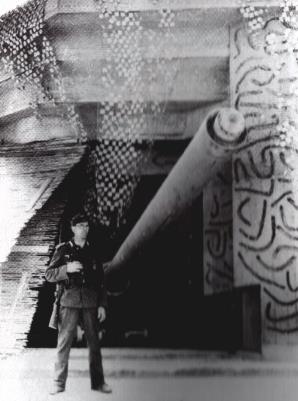
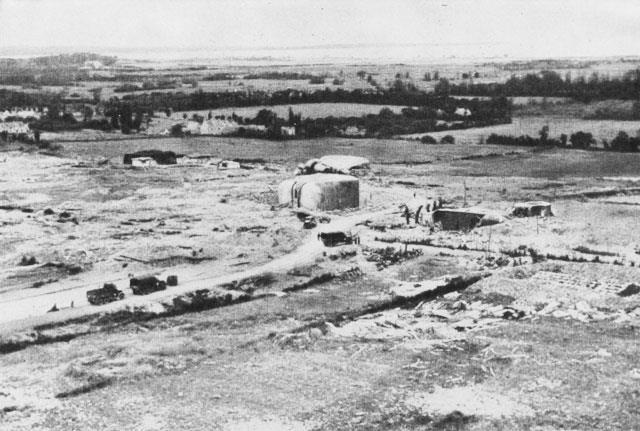
Left, prior to the
allied invasion a German soldier stands guard in front of one of
the 210mm guns at Crisbecq.
Right, one of the batteries at Crisbecq, photographed some time
after its capture.
The stiff German resistance met by Dowdy and 1st Battalion as
they approached the fortifications took a murderous toll on the
22nd infantry.
From 1900 to 2000 hours, Col Ruggles was informed that all three
aerial bombardment missions would be flown by 2130 hours by B-26
bombers.
Col Ruggles informed 1st Battalion of the air mission. Maj
Dowdy came on line and requested an artillery barrage on
Fintenay-sur-Mer. Ruggles followed this call
with a call to artillery to put a 5 minute barrage on
Fontenay-sur-Mer. While Col Teague at 3rd Bn was talking to Col
Ruggles at 1920 hours, the line went dead
but not before Teague informed Ruggles that the area was filled
with machine gun fire and German 88mm fire. Maj Dowdy
at 1st Battalion asked Col Ruggles
about the status of the artillery request. Dowdy
also said that German 88's were opening up on tanks in his area.
The 88's were reported to be north and east of Ozeville.
At 1940 hours, Maj Dowdy at 1st Battalion
reported the onset of a counterattack by the Germans on the right
flank of Company A and that his company
was being pushed back. The 2nd Battalion is not in contact with
Company A or Company B but is trying to build up the line. Dowdy
was also trying to contact
Col Teague at 3rd Battalion. Maj Dowdy reported
to Col Ruggles that the 2nd Battalion is now in front of the 1st
Battalion line. 1st Battalion is requesting artillery
for that area. The 2nd Battalion is withdrawing from the area to
be fired on.
From 2000 to 2100 hours, the 3rd Battalion reported that Company
K with replacements had reached their headquarters. They request
Regiment to see
if naval fire will do any good for Col Teague against Ozeville. A
naval observer arrived with Company K. Regiment reported that
there is a naval observer in the area
which is to be bombed at 2130 hours. Col Watson asked how he got
in there because all infantry outfits were notified and to get
him "the hell out of there."
Col Ruggles to Capt Goforth at the 3rd Bn, if you have not made
any progress by 2100 hours, stop and dig in for the night.
Get hold of Maj Dowdy at 1st Battalion and tell
him the same thing.
June 11, 1944
From 0730 to 0900 hours, Maj Kenan was informed that the air
mission was approved. Gen Barber and Gen Roosevelt discuss having
strafing missions
flown over the enemy lines. Gen Roosevelt said it was better to
chance a strafing of our own troop than not to call for any at
all. Gen Barber told him
all about yesterday's activities. The 8th Infantry and the 12th
Infantry follow the tactic of keeping their tanks with them right
in the rear to follow them up.
Maj Dowdy with 1st Battalion told Col Ruggles that he
did not plan to move much before 0930 hours today. Gen Barber
clarified the order for Maj Dowdy
and told them to get going just as fast as possible. Dowdy
was told to keep his troops up with the tanks. In that way more
good can be gained from their use.
June 12, 1944
About 0300 hours, Col Foster wanted the battalion commanders to
report to the CP for a meeting on today's activities. They may
bring along any desired staff officer.
Also, alert Col Teague of the 3rd Battalion that he will lead the
attack in the morning and for him to draw all supplies he needs.
Regimental runners
were sent to all units except the 2nd Battalion. Capt Kent sent
the liaison officer to the 2nd Battalion. Maj Kenan and Col
Foster returned
and started to work on field orders for the attack. At 0430
hours, Maj Dowdy with 1st Battalion and Capt
Branigan arrive at the CP to receive the attack order.
Col Teague with 3rd Battalion was also present. Communication was
reestablished at this time with the 3rd Battalion. Maj
Dowdy reported
that a small counterattack was developing on his right flank, but
believed that the artillery would put it down.
Maj Edwards with 2nd Battalion arrived at the CP short time later
to receive his orders for the day."
From 0800 to 1000 hours, the General wanted overlay dispositions
of all units in the 22nd Infantry and attached units with
artillery fire dispositions.
Col Ruggles told the 1st Battalion that the air mission is out. Maj
Dowdy is going to use naval fire. Col Ruggles said the
air mission might go through.
Notify Maj Edwards to pull his 2nd Battalion troops back.
From 1900 to 2000 hours, Maj Dowdy with 1st
Battalion gave Regiment the general situation of the 1st
Battalion. He said they would try to push up
and to the right of 3rd Battalion. Maj Edwards at 2nd Battalion
is asking about the general situation. He will contact Col Teague
at 3rd Battalion.
He also inquired about the 12th Infantry's location saying that
there is a gap between his unit and the 12th Infantry. Maj
Edwards and Capt Goforth at Regiment
with the help of Maj Kenan, are getting squared away as to what
the objective is and the zone of action.
June 13, 1944
From 0500 to 0700 hours, communications were back up with
Division and two battalions, the 1st and 3rd. There was still no
contact with the 2nd Battalion.
The air mission request was denied. Regiment informed Gen Barton
about the 2nd Battalion being contacted and it being on the move.
Gen Barton told Regiment
to make a practice of knocking out enemy observation posts. Also
that Reconnaissance would be used to fill the gap between the 2nd
and 3rd Battalions.
Maj Dowdy, with 1st Battalion, told Col Foster
that he was set up but the 1st Battalion was in pretty bad shape.
Further, he told the Colonel
that Fontenay-sure-Mer had not been taken when he was by there
early this morning.
June 14, 1944
From 1600 to 1800 hours, Maj Dowdy with the 1st
Battalion reported that they were on their objective. He said the
1st Battalion got the hell shot out of them.
He needs some fresh men. Says his men have gone about as far as
they can go. He would like some fresh men to patrol, etc and
needs officers badly.
The 3rd Battalion was notified that the 39th Infantry was
attacking the town of Quineville at 1615 hours. Quineville is on
the right flank of the 3rd battalion.
The 2nd Battalion reported they were receiving heavy artillery
fire from the northwest. Capt Kent is on his way to the 1st
Battalion. Two other officers have already arrived.
Col Foster is also going to look the situation over. The 3rd
Battalion of the 39th Infantry is pushing up to Quineville and is
staying south of the road.
The Germans are setting off demolitions in Quineville. Somebody's
artillery fire was falling in their zone of operation.
June 15, 1944
From 0800 to 0900 hours, Maj Dowdy with the 1st
Battalion reported that they have a lot of dead and wants them
picked up.
Dowdy had a pretty rugged night last night. A
lot of the enemy that were overlooked in the Allied advance were
trying to get back to their lines.
Today, the Regiment is getting new replacement officers and
enlisted men. Regiment wants to get the battalion commanders
together to make an even distribution
of experience of the new officers among all units. Col Ruggles
asked 1st Battalion about supplies and rations and was told they
are coming along fine.
Ruggles told them not to fail to call if he could do anything for
him and he would try to fill any request. He also asked how it
feels not to be attacking.
Maj Dowdy wants eight machine guns. Maj Kent asked him
if he is getting plenty to eat. Dowdy says yes
that supplies are okay. Col Ruggles sent Lt Henry
to 3rd Battalion 39th Infantry to extend a welcome on being
temporarily attached to the Regiment. He also told them where the
water dispensing point is
and to coordinate how to pass information back and forth.
From 1100 to 1300 hours, Col Teague notified the 3rd Battalion
that the unit from the 39th Inf is being released and that
Company C 4th Eng Battalion
is coming under their command to help hold their position. He
also told the 3rd Battalion to keep patrols out and bridges under
fire and observation.
Maj Dowdy with 1st Battalion reported to Col Teague that
they were moving their CP closer to the front lines because they
were too far back.
A captain from the Recon Battalion reported to Col Foster and
received instructions. Recon is to send a command armored car to
the command post
to keep contact with Recon. Recon has a bicycle platoon of
over-strength just in case it is needed fast.
June 17, 1944
From noon to 1400 hours, Col Foster told Maj Dowdy
in 1st Battalion and Maj Edwards in 2nd Battalion to seek out and
find any of the cables in their area
formerly used by the enemy and cut them. The 3rd Battalion is to
have the Montebourg job. Their first objective is to contain it
while it is being by-passed
by other units and then to take it. Col Foster and Col Teague
with 3rd Battalion then talked over the plans for relieving the
8th Infantry from the area of Montebourg tonight.
The 1st Battalion spotted the enemy observation tower and is
going to throw Naval fire on it. Regiment is going to let
Division know what we are doing.
One of the battalions has captured a German ammunition dump that
the enemy is trying to recapture. We have permission from
Division to blow it up.
June 19, 1944
From 0600 to 1100 hours, the 1st Battalion reported that all was
still quiet. The unit on their right had some fire fighting. No
trouble getting into position last night
except for a little shelling of roads while on the move. No
casualties were reported. At 1020 hours, Maj Dowdy
at 1st Battalion was given the location
of German mortars, machine guns and artillery that the
reconnaissance group had located. Dowdy was not satisfied with
his position that he took over.
Col Foster said he could make slight changes to improve it if he
liked. Dowdy wanted the anti-tank mine platoon
to lay some landmines in front of his position
to protect his front. Division wanted to know if Company K knew
what was in Montebourg. Maj Kenan told them the story about the
prisoners last night.
The 1st Battalion was asked to make a recon of the area to their
right. Maj Edwards from the 2nd Battalion said he could move in
45 minutes.
June 21, 1944
From midnight to 0200 hours, the 3rd Battalion gave their report
on patrols about where the enemy was located. Machine guns,
mortars and snipers fired upon them.
Major Dowdy with the 1st Battalion wants to
speak to Col Foster regarding whether or not he should keep going
or not. He had met resistance and fired his artillery
but said he could not tell before morning whether he was rid of
them or not. Col Foster said for him to hold his present position
and not to push any further.
The message center called and said a 24th Cavalry Lieutenant
brought some French civilians in who wanted to volunteer giving
some information about enemy.
The 3rd Battalion said that two men returning from patrol
reported our artillery shells bursting behind our lines. It
turned out to be "Causeway" artillery group.
June 24, 1944
From 0800 to 0900 hours, Col Foster asked the 1st the 3rd
Battalions what was going on in their areas this morning. Col
Teague with the 3rd Battalion
said there was a hell of a lot of artillery, snipers and
infiltrating during the night. Teague wanted a platoon of
engineers to help him hold his position.
Maj Dowdy with 1st Battalion was told to hold the high
ground. Foster does not want the battalions to spread out too
much. Foster told Teague
to leave a platoon to help Dowdy. Maj Edward
with the 2nd Battalion then came in and said he was worried about
the fact that the 2nd Battalion did not have
priority on cannon or chemical mortar fire in its attachment to
the 12th Infantry. Col Foster reassured him that he probably
would not need it but if he did
he would get fire for him. Company E did not leave their position
as planned. They thought there was a guide coming for them and
were waiting for him.
Gen Roosevelt visited the CP. He is a very interesting man and
talked about the history of battle, etc. He said prisoners taken
yesterday were a mixed lot.
There was some from every conceivable organization. Some were
marines who were just issued army uniforms the night before. Some
were Italians
and some were forced laborers taken into the army. It looks like
the enemy is hurting for everything.
June 25, 1944
From 1000 to 1500 hours, Col Foster talked to Maj Dowdy
in 1st Battalion about the patrols that went out last night.
Foster told Dowdy
that he was doing a good job. Col Foster told Col Goforth in 3rd
Battalion to prepare to attack west. No time given. Maj White
with 2nd Bn reported by radio
that they had reached their intermediate objective with no
resistance. They are reorganizing and preparing to advance. We
have moved the Regimental CP
for the second time this morning. The first CP was very
unsatisfactory being in open ground on top of a hill with no
trees. The second CP is much better.
We are contemplating moving again later on this evening if
operations are successful. Division notified Regiment that there
will be an air mission
on the Maupertus airfield from 1200 to 1400 hours which was
successfully completed.
June 26, 1944
From noon to 1500 hours, the 3rd Battalion reported that the 2nd
Battalion is firing into their zone of action. Maj Kenan told Col
Goforth that a platoon
of engineers are going to the aid of the 3rd Battalion. Maj Kenan
reported that as soon as Cherbourg falls tomorrow, the commanding
officer
of the 3rd Battalion will pick a rifle platoon and send them to
the supply train bivouac area to get cleaned up and get new
uniforms to participate in a victory parade
in Cherbourg. Col Foster talked to Maj Doughty
with 1st Battalion about their front line. Maj Doughty
reports resistance by two machine guns
that caused 6 casualties. Both are being out flanked and will be
taken. The Colonel suggested sending prisoners back to enemy
strong points
to encourage surrendering or artillery would blast them out.
From 1900 to 2000 hours, the 3rd Battalion reported taking their
number one objective and were moving onto number two. 40
prisoners were being sent back
to Regiment. Col Foster checked with Maj Kent on the status of
salvaging abandoned equipment along roads and about arms and
equipment of replacements.
The present set-up is satisfactory per Foster. The 2nd Battalion
reported that they are tucking in the front lines. They are under
sporadic machine gun and artillery fire.
The 44th Field Artillery observer is going to direct fire into
enemy positions all night in order to plaster them all night for
the attack tomorrow.
Maj Dowdy reported to Regiment that the 1st
Battalion is on their number nine objective and will jump off
onto number ten as soon as they are reorganized.
He would like the 24th Cavalry on his left flank if possible. Col
Foster checked with 3rd Battalion to see if they had a naval
gunfire liaison officer.
They did not have one. Col Foster will get them one to direct
fire on an enemy gun position on some high ground that is
harassing both the 3rd and 1st Battalions.
Maj Dowdy with 1st Battalion reported to Col
Foster that they do not have a naval shore fire officer either. Dowdy
is on his number nine objective
and has captured about 50 prisoners in conjunction with the 24th
Cavalry. He is in the process of capturing more prisoners.
Dowdy's men are lobbing hand grenades
at the Germans at this time. He will dig in when he gets to his
objective number ten. The 2nd Battalion reported that they did
not have a naval shore fire officer either.
One is being requested from Division.
From 2000 to 2200 hours, the 3rd Battalion reported moving
forward and is cleaning up around the small town of Maupertus
they have taken.
The 1st Battalion requests a company of men on their left flank
to take objective number 10. Col Foster maintains that Point 10
will not offer enough resistance
to force the 1st Battalion to expend enough men to leave its left
flank weakened. He is not sending the requested reinforcements
until further investigation
by Maj Dowdy, if at all. The 2nd Battalion
reported casualties at about 24 for the day. The 1st Battalion
reported their taking objective nine.
They will secure the ground and settle down for the night. Maj
Kenan reported the situation to Division. The General wants
Regiment to resume its attack
by 0800 hours on the 27th. Kenan asked for tanks and mortars.
The above excerpts were taken from the book:
David Andrews
The Road from Calendonia to Canisy
One Man's Journey from Home Through World War II
And Back
By Bill Andrews
All excerpts used with permission of the author.
Bill Andrews wrote the above
book to honor the memory of his Father, David Andrews, who served
with Company E 22nd Infantry.
His Father landed on Utah Beach with 2nd Battalion 22nd Infantry
in the second wave of the landings on D-Day,
and served as Platoon Sergeant for 3rd Platoon of Company E,
until seriously wounded on July 26, 1944, during the breakout
from Normandy in Operation Cobra. This excellent book recounts
the the actions of the 22nd Infantry Regiment during that period.
For further reading, and the full story from which the above
excerpts were taken, the book is highly recommended.
Copies of the book may be ordered by contacting Bill Andrews at:
caledonia2canisy@bellsouth.net
**********************
The Death of LTC John Dowdy
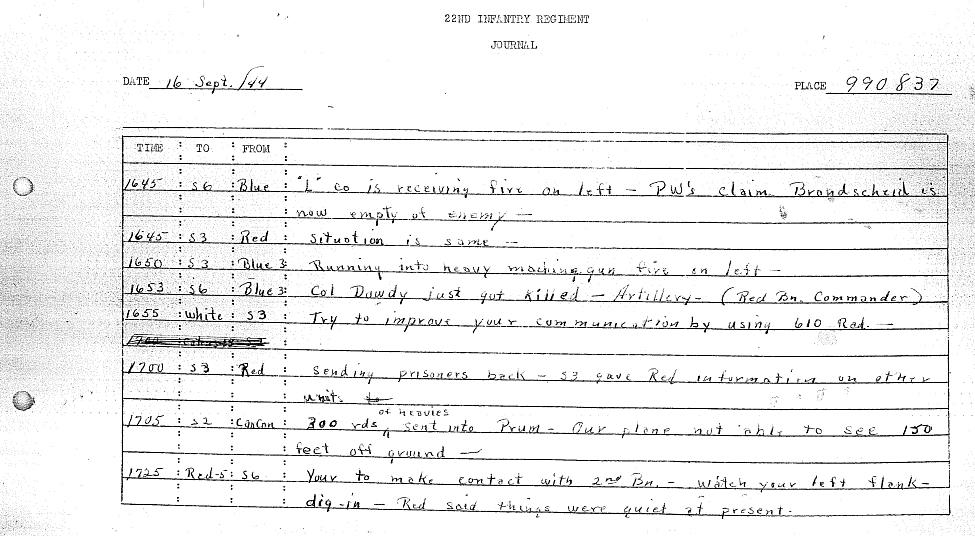
Above: the entry in the Daily Action Journal of the 22nd Infantry for September 16, 1944, announcing the death of John Dowdy.
On the line that begins with "1653" is the simple entry:
Col Dowdy just got killed - Artillery - (Red Bn. Commander)
That single line explains
that.........On September 16, 1944, at 4:53 p.m. (1653), the
operations officer for 3rd Battalion 22nd Infantry (Blue 3)
informed 22nd Infantry Regimental Headquarters (S6) that
Lieutenant Colonel John Dowdy was just killed by enemy artillery
fire,
and that he had been Commander of 1st Battalion 22nd Infantry
(Red Bn. Commander).
On September 12, 1944, a
reconnaissance patrol of the 22nd Infantry was the first American
unit to penetrate into Germany.
A three Division attack upon the Siegfried Line was planned by V
Corps for September 14. The 4th Infantry Division
would be responsible for a front from Schönberg to the north to
Brandscheid to the south, attacking through the southern half
of the Schnee Eifel, a heavily wooded mountainous region of
central Germany.
22nd Infantry was given the task
of advancing through the Bleialf-Prüm corridor, with the aim of
seizing the vital crossroads city
of Prüm itself. On September 14 the Regiment moved forward in a
series of leap frogging attacks by its three Battalions,
each Battalion alternating as the lead assault element as the
attack progressed. On September 15 the town of Brandscheid was
taken,
and the Regiment pushed the Germans back along the highway toward
the town of Sellerich.
As the 22nd Infantry approached
Sellerich on September 16, 1st Battalion, under command of LTC
Dowdy, attacked and
seized the high ground to the west of the town. Despite heavy
artillery and mortar barrages, and a series of counterattacks
by reinforced units of the 2nd SS Panzer Division, Dowdy and his
men dug in and held the critical hill which overlooked
the highway into Sellerich. During repeated shelling by the
enemy, Dowdy continued to personally move about
his different Companies' positions, not only making sure all
defenses were strong and well-placed,
but also talking and joking with his officers and enlisted men,
instilling confidence in them, and inspiring determination
to hold on to the hill. He made two complete rounds of his
Battalion's positions, and, not satisfied that he had done
enough,
was on a third round, when an enemy shell sent a deadly fragment
into him, killing him instantly.
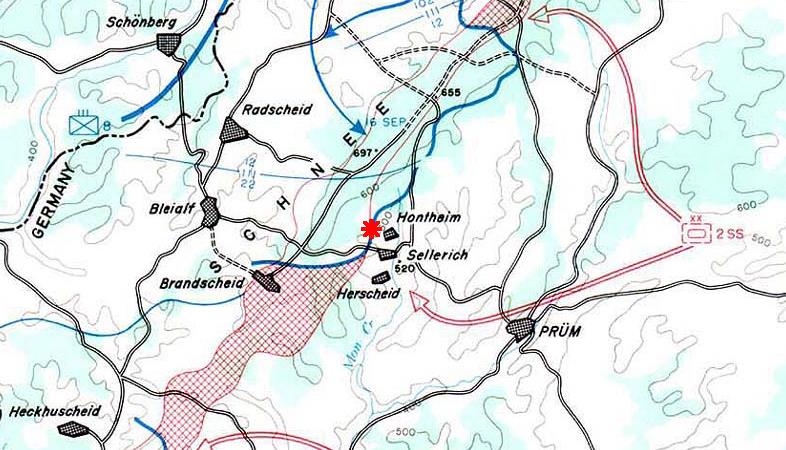
The above map shows the advance of the
22nd Infantry into Germany in September of 1944.
Sellerich lay nearly midway along the Bleialf - Prüm highway.
As indicated on the map, the 22nd Infantry was opposed by the 2nd
SS Panzer Division (Das Reich),
an elite organization and veteran of many campaigns, determined
to defend their homeland against the Americans.
The red asterisk ( * ) marks the approximate
location of the high ground outside of Sellerich
that was taken and held by the 1st Battalion under LTC John
Dowdy. It was here that LTC Dowdy lost his life.
Map from The
Siegfried Line Campaign
by Charles B. MacDonald
Map cropped and asterisk added by the webmaster
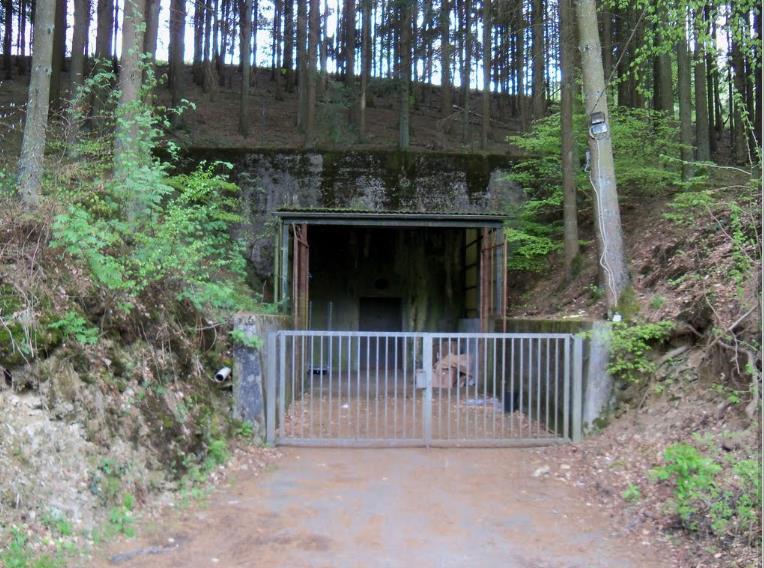
One of the German concrete fortified
positions in the hills outside of Sellerich.
Built to withstand aerial and artillery bombardment, such bunkers
allowed the Germans protection
of their men and material, making the "softening up"
phase of the American assault on Sellerich nearly useless.
LTC Dowdy and 1st Battalion advanced on to the high ground west
of this bunker only to meet an enemy
who emerged intact and fully ready to resist the American attack.
Photo by mannheim from the website Panoramio
|
Left: Newspaper article reporting that John Dowdy had recovered from his wounds and was returning to duty. Right: Newspaper article announcing the death of LTC Dowdy. This article appeared in the paper during the first week of October, only a day or so after the previous article which announced that John Dowdy was returning to duty. Note that the first article appeared a month and a few days after the fact of his return to duty, and the second article appeared nearly three weeks after his death. |
|
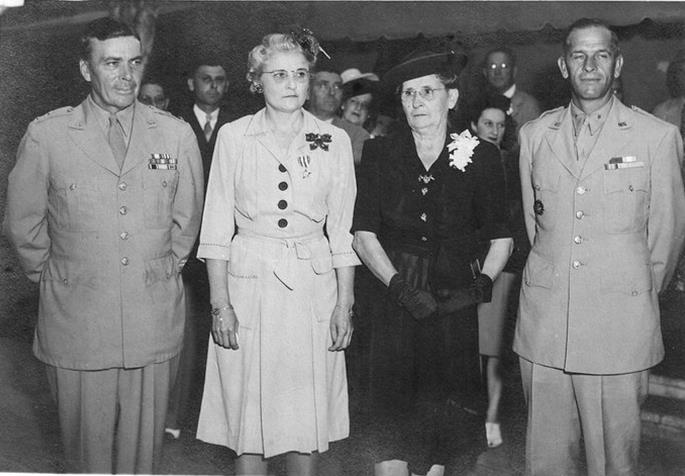
From left: Major Gen. Raymond O.
Barton, Eva Dowdy, Nevada Bryan, and Brig. Gen. James H. Walker
at the presentation to Mrs. Dowdy of the Silver Star Medal
awarded to her son, LTC John Dowdy, Miami, Florida, March 1945.
This presentation was for the second Silver Star Medal awarded to
LTC Dowdy ( posthumously ),
for his actions in combat of September 16, 1944, the day he died.
As Commanding General of the 4th Infantry Division General Barton
was Dowdy's Commander in Europe.
The above photo appeared in The Macon
Telegraph, March 27, 1945.
The article which accompanied the photo read in part:
"MIAMI
BEACH, Fla. March 26 --- A posthumous Silver Star for gallantry
in action was awarded here to
Mrs. Eva Mae Dowdy, of Helena, Ga., for her son, Lt. Col. John
Dowdy, 26, killed in Germany.
Award of the medal was made by Maj. Gen. R.O. Barton, formerly
commanding general of the famed
Fourth Infantry Division, in which Colonel Dowdy was a battalion
commander. General Barton
recently returned to the United States and made the award while
resting at the Army Ground and
Service Forces Redistribution Station here.
About 30 friends
and relatives of Mrs. Dowdy attended the simple but impressive
ceremony held in the patio
of the Albion hotel, headquarters of the redistribution station.
Brig. Gen. James H. Walker, commanding
general of the station, read the citation before General Barton
presented the Silver Star."
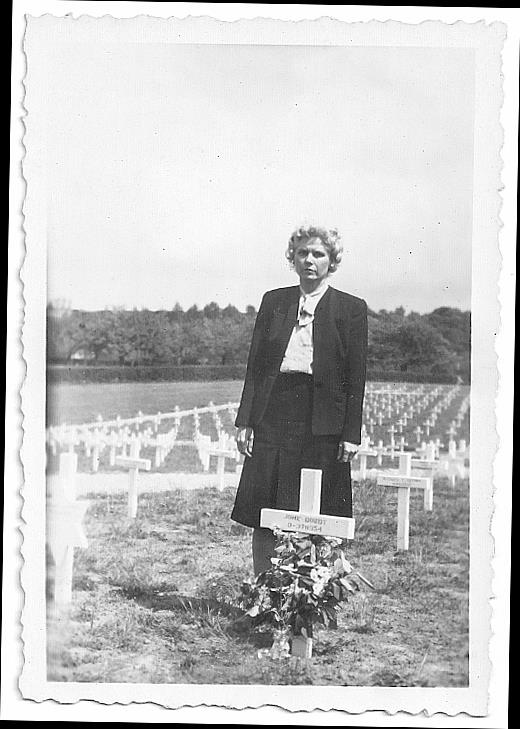
John Dowdy's Aunt, Elizabeth Bryan
Stallings McPherson -- at John's grave site in Belgium. (1947)
In 1949 his remains would be brought home to the United States
aboard the troopship USAT Barney Kirschbaum
and interred in a plot in the cemetery at Tifton, Georgia, where
he rests today.
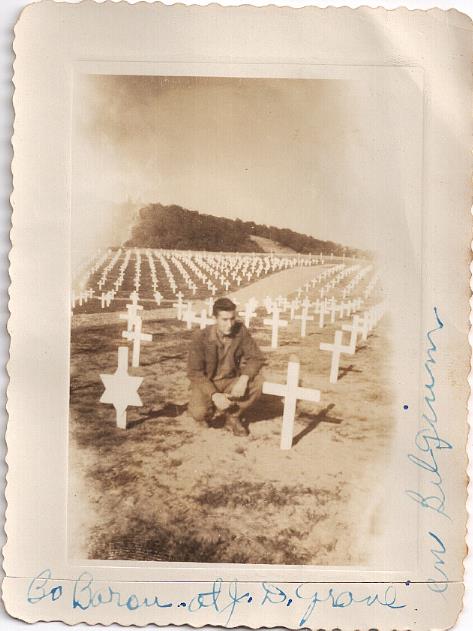
Bo Baron at John Dowdy's grave.
Positive identification of Baron could not be established.
**********************
The following is the entire
letter written to John Dowdy's mother, by Colonel Charles T.
"Buck" Lanham,
expressing his condolences on the death of her son. Lanham did
not want to send the letter to LTC Dowdy's
mother, until he was assured that the War Department had notified
her of her son's death.
Therefore, although he wrote the
original letter on September 16, 1944, the day LTC Dowdy died,
he waited until October 27 to send the letter to John's mother.
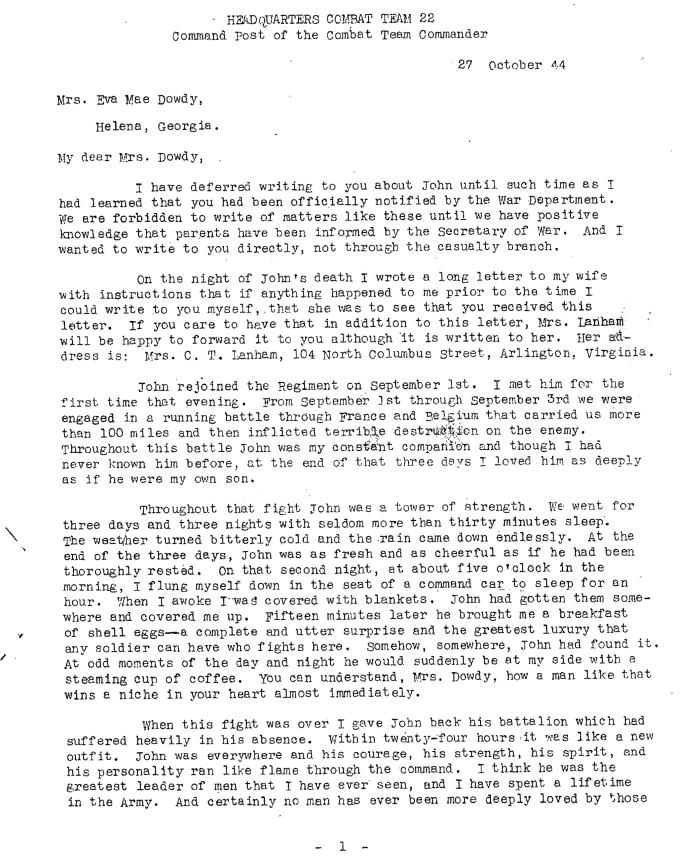
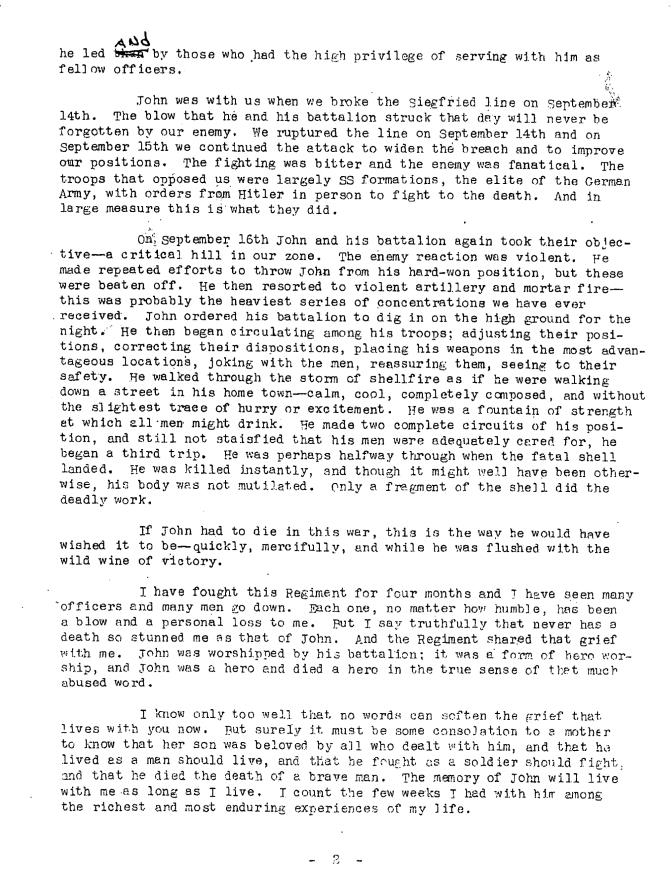
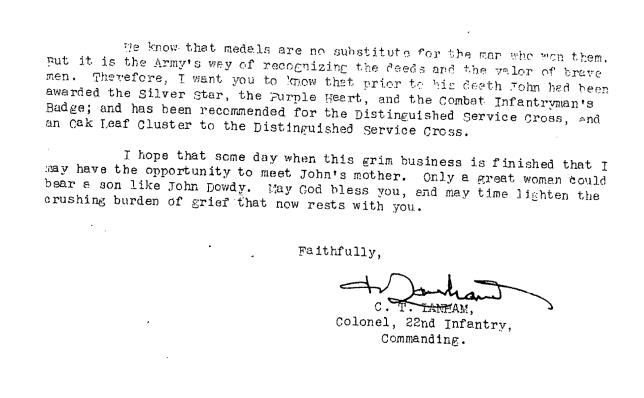
**********************
The following is the letter
Colonel Lanham wrote to his wife on the day John Dowdy died.
Lanham had to wait before he could send Dowdy's mother the above
letter, and, fearing he himself
might be killed before he could send that letter, he sent this
one to his wife, charging her with
making sure Dowdy's mother knew what Lanham thought of her son.
Such was the respect which LTC John Dowdy inspired in his Regimental Commander.
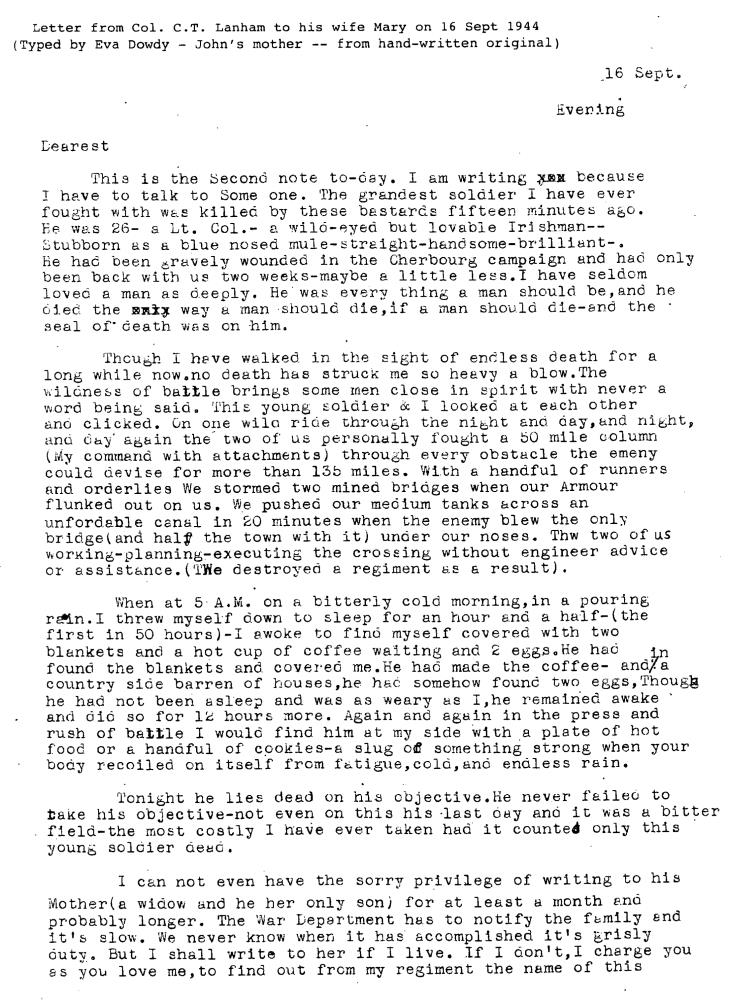
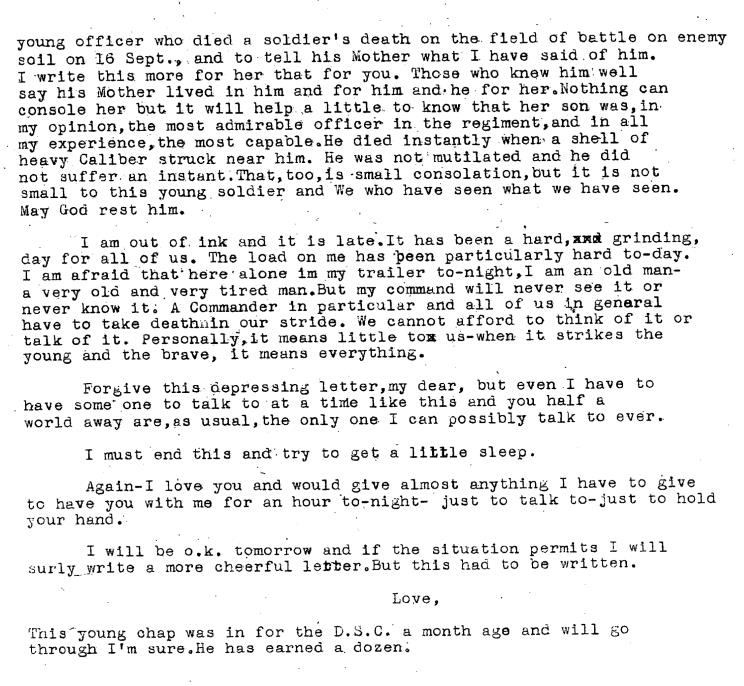
**********************
The 1st Battalion website is grateful to Karen
Scott for the above photos and memorabilia of her cousin, John
Dowdy.
Karen's dedication to preserving the memory of her ancestor
insures that LTC Dowdy's legacy will always be remembered.
Thanks to her, this important chapter has been written, in the
history of 1st Battalion and of the 22nd Regiment of Infantry.
All photos, letters, articles and memorabilia concerning John Dowdy used on this page are copyright © 2009-2011 by Karen Scott
Home | Photos | Battles & History | Current |
Rosters & Reports | Medal of Honor | Killed
in Action |
Personnel Locator | Commanders | Station
List | Campaigns |
Honors | Insignia & Memorabilia | 4-42
Artillery | Taps |
What's New | Editorial | Links |